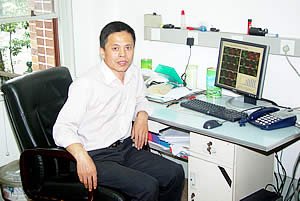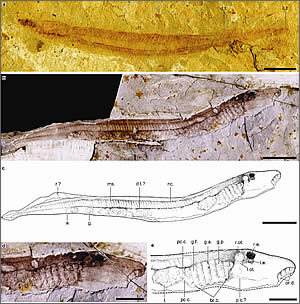
|

|
No.47 August, 2006 |
| |
Latest Research on Glial Synapses Published by Science
The June 9 th issue of Science published the latest discovery, made by a research team headed by Prof. Duan Shumin from the Institute of Neuroscience, CAS, that glial synapses have plasticity.
The brain is made up of two kinds of neural cells: neurons and glial cells. Synapses are the key structure for signal transmission and process among neurons. However, CAS scientists, including Research Fellow Duan Shumin and his doctoral students Ge Wuping and Yang Xiujuan, have found after four-years hard work that the function of these synapses is changeable, or plastic. The plasticity of synapses, known as long-term potentiation (LTP), is related to the learning and memory. In most cases, the LTP induction in neuronal synapse results from the activation of the NMDA receptors which do not exist on NG2 cells. Instead, these NG2 cells have Ca+2-permeable AMPA receptors. By activating the latter, LTP can be induced in these glial cells. As there are numerous NG2 cells in the brain, the discovery of the synaptic plasticity in the glial cells and its underlying mechanisms may be of significance to the understanding of how the brain works and may hint at future research on brain functions.

2 nd International Palaenontological Congress Held in Beijing
The Second International Palaeontological Congress (IPC2006) was held from June 17 to 21 in Beijing.
As part of a series of academic meetings of the International Phonetic Association (IPA), the tiptop organization in the international palaeontological community, the Congress is held every four years and represents the highest level of the world palaeontological discipline. IPC2006 showcased the research level and the important achievements of China's paleontologists. IPC2006 brought together more than 600 palaeontologists both at home and from some 50 countries, such as USA, Russia, Japan, UK, Germany, France, Sweden, Canada, Czech, Italy, Belgium, Poland, etc.
With the theme of "Ancient Life and Modern Research Approaches", the Congress focused on a series of scientific sessions and symposia to discuss new research findings relatd to fossil organisms.-8
Protein-chip-based Biosensor Successfully Developed
A research team led by Prof. Jin Gang from the National Microgravity Laboratory, Institute of Mechanics, CAS has succeeded in developing a protein-chip-based biosensor and its applied sample.
The kernel technology of the new microarray, called ProteinChips, is a new protein analytic system with the advantage of integrated, parallel, fast and automatic analysis. The research provided a new label-free technique for protein analysis by the combination of microarray with multiprotein activity, the specific binding of biomolecular, and the imaging ellipsometry with high spatial resolution. Besides, the protein solution delivery, the fabrication of the protein microarray, and the interaction of protein can be accomplished by a microfluidic protein microarray reactor system. Meanwhile, the system features 48 individual cells, which can detect 48 kinds of sample or 48 proteins in one or several samples can be detected simultaneously which largely reduce the measure time and the sample consumption. Moreover, there is little cost for the ProteinChips production except for the reagent when utilizing the system to detect the protein samples. -9
Kunming Declaration on Conservation of Asia Tropical Forests Announced
The 2006 annual meeting of the US-based Association for Tropical Biology and Conservation (ATBC 2006) was held recently in Kunming. There were 320 biologists from 43 countries and regions present at the meeting. The conference announced a Kunming Declaration for the conservation and strategic research of tropical forests in Asia.
The Declaration urges that the nations of tropical Asia should expand the number and size of their reserves within their territories, and special attention has to be paid to those areas where forest types and eco-regions that are poorly protected, and to the areas where highly vulnerable megafaunas are found.
It strongly suggested that the reserves be linked wherever possible into regional networks and cross-national corridors, to increase their size and effectiveness for area-sensitive wildlife, and to reduce their vulnerability to many external threats. It also made strong advices that policy makers in the region engage in active dialogues with scientists, in order to better understand the critical challenges facing the region and its vital natural resources.-10
New Lamprey Fossil Discovery Published by Nature
The June 22 nd issue of Nature published the latest study on a new species of lamprey, jointly made by Zhang Miman, member of CAS and Research Fellow Zhang Jiangyong, both from the Institute of Vertebrate Paleontology and Paleoanthropology (IVPP), CAS as well as Miao Desui (Ph.D.) from the University of Kansas. Named as Mesomyzon mengae after Prof. Meng Qingwen, a renowned ichthyologist at the Shanghai Fisheries University, the finding is believed to be a new genus and species of freshwater lampreys from the Early Cretaceous epoch (about 125 million years ago).
The well-preserved specimens were unearthed from the Early Cretaceous strata of the lower Yixian Formation in Ningcheng County of China's Inner Mongolia, carrying the world-famous Jehol Biota. It is the first discovery of the lamprey fossil from Mesozoic strata on the Eurasian landmass and in a freshwater ecosystem according to experts.

copyright © 1998-2005
CAS Newsletter Editorial Board: 52, Sanlihe Road, Beijing 100864,
CHINA
Email: slmi@cashq.ac.cn